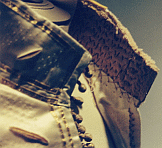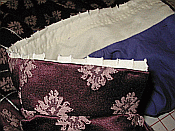August, 2005.
DOUBLET:
|
|
My main reference for the doublet was Janet Arnold's Patterns of Fashion. This has extant examples of both elizabethan and Italian doublets, including the stitching, collar, buttons. Left is the main influence for the final look of Dafydd's doublet. It is to have short sleeves, to be worn over his linen rapier shirt. This will make a cooler option for rapier tourney in the hot summers of Innilgard (Adelaide, SA) where temperatures can reach into the 40 deg Celcius range. |
- 4 layers over the body, (2 layers on the doublet, and 2 layers on the linen shirt)
- 4 layers covering the armpit (already 4 layers in this area for the linen shirt).
- there should be enough overlap were any join may allow the rapier to go, to not allow the baring of skin.
Below are pictures of the Pattern pieces I used, based on those in
Patterns of Fashion. I added a 3 inch overlap at the front
buttoning. The sleeves have a seam near the side back. I did add
gussets, to the sleeves, to help aid movement for tourney. Adding
them at the side back meant that there was more movement when lunging
forward. If I had put them on the traditional, modern underarm seam,
this would allow for upward movement. However, there is not much call
for holding the rapier up vertically above the head (unless being
attacked from above, I would suppose!).
|
|
A reminder on the material ... This is the visible layer. The lining is of cotton drill. (I had a whole heap left over in my stash). The skirts were to be edged with bias binding (examples of this can be seen in Janet Arnold). The sleeves will have couched, metallic silver thread to give the diamond design. I also decided to add linen bias cut, picadils to the neck and down the front opening, to add some decoration. This will be less bulky than box pleating. Again, examples of this can be seen in Patterns of Fashion. |
|
|
|
|
|
Proper tailored lining of the collar. herringbone stitch close up (inside) |
(outside of the lining). |
The stiffened collar of the lining |
|
|
For this doublet, I did not want to cheat and use rope
stiffening for the collar. I have no research to back up the
rope stiffening. Also this would make the collar too thick.
For rapier protection, the neck is covered by a thick coif
with a metal and leather gorget underneath. |
Decorations:
|
|
|
|
Above R: I made bias from the linen left over from the doublet shirt. I also used the same bias to handsew to the edge the skirts. (below).

|
|
|
|
|
|
The sleeves: I couched some (you guessed it!) silver metallic thread I had in my stash: |
Buttons: |
Inside the doublet: the lacing strip. This will lace the doublet to the trews, helping to reduce the chances of the two coming adrift. This is desirable for rapier garb safety. |
The lining was blindstitched in place. |

|
 |
Bibliography:
- Egerton Castle, Schools and Masters of Fencing - from the Middle Ages to the Eighteeenth Century. Dover Publications. NY, reprint 2003. ISBN: 0-486-42826-5
- Lochac Rapier Rules:
- Web Gallery of Art: http://www.kfki.hu/~arthp/html/
- Arnold Janet, Queen Elizabeth's Wardrobe Unlock'd, Maney, Leeds, 1988, ISBN:0-901286-20-6
- Arnold Janet, Patterns of Fahsion, MacMillan, London, 1985. ISBN: 0-333-38284-6
- Juan Alcega's Tailor's Pattern Book, 1589 Facimile, Ruth Bean, Carlton, Bedford, 1979.
- The Milanese Tailor's Handbook http://costume.dm.net/Tailors/
- Tudor & Elizabethan Portraits: http://www.tudor-portraits.com/Costumes.htm
- "How much yardage is enough" Susan Reed, 1994. http://patriot.net/~nachtanz/SReed/fabuse.html
- Suggested Yardages for Elizabethan Garments by Drae Leed. http://costume.dm.net/yardages.html# (29/5/03)
- Renaissance Tailor (making buttons) : http://www.vertetsable.com/demos_buttons.htm
- Tribute to Janet Arnold V&A Museum: http://www.kipar.demon.co.uk/arnold.html
All intellectual content, photos and layout are copyright to La Signora Onorata Katerina da Brescia (K Carlisle), except those original renaissance artworks and extant articles whose copyright remains with the current owner.
2005












